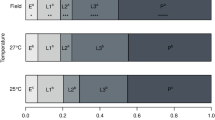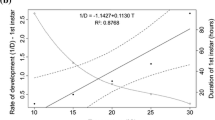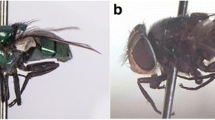Abstract
In the field of forensic entomology, Chrysomya rufifacies (Macquart 1843) (Diptera: Calliphoridae) has proven to be an important species for postmortem interval (PMI) assessment in criminal investigations. The developmental patterns of C. rufifacies exhibit temperature-dependent variations that are geographically specific, and these variations are influenced by seasonal changes. Hence, understanding the geographically specific development patterns of C. rufifacies in response to temperature and seasonal changes is crucial for improving the accuracy of PMI predictions. In the present study, we examined the developmental rates of C. rufifacies across a temperature gradient (20 °C, 25 °C, 30 °C, 35 °C, and 40 °C). Primary objective of present study was to gather precise developmental data essential for calculating the post-mortem interval (PMI) within varying temperature ranges. Furthermore, we investigated the influence of seasonal variations, encompassing the summer, rainy and winter seasons, on the growth and developmental patterns of C. rufifacies. The results of present studies show that temperature significantly affects the growth and development of C. rufifacies. The length of developmental stages and morphological parameters varied seasonally, with longer duration and colder temperatures in winter and shorter duration and warmer temperatures in summer. The finding that faster development was directly correlated with higher temperatures highlighted the significance of temperature in affecting an insect’s life cycle. Our research highlights the necessity of gathering information on evolution trends that are specific to a given area in order to accurately calculate PMI in forensic entomological investigations. Understanding the interactions between temperature, seasonal variation, and morphological traits is critical for establishing baseline data for PMI estimates. The accuracy of PMI estimates will ultimately increase thanks to this information, and forensic entomologists will have even more opportunities to contribute to forensic investigations.







Similar content being viewed by others
Data availability
The data and the results used to support the findings of this study are presented in the manuscript.
References
Keh B (1985) Scope and applications of forensic entomology. Annu Rev Entomol 30:137–154. https://doi.org/10.1146/annurev.en.30.010185.001033. PMID: 3882048
Greenberg B, Kunich JC (2002) Entomology and the law: flies as forensic indicators, 248 edn. Cambridge Univ. Press, Cambridge, pp 102–103
Sukontason KL, Sukontason K, Narongchai P, Lertthamnongtham S, Piangjai S, Olson JK (2001) Chrysomya rufifacies (Macquart) as a forensically-important fly species in 272 Thailand: a case report. J Vector Ecol J Soc Vector Ecol 26:162–164
Sukontason KL, Sukontason K, Lertthamnongtham S, Kuntalue B, Thijuk N, Vogtsberger RC et al (2003) Surface ultrastructure of Chrysomya rufifacies (Macquart) larvae 278 (Diptera: Calliphoridae). J Med Entomol 40:259–267
Sukontason K, Piangjai S, Siriwattanarungsee S, Sukontason KL (2008) Morphology and 274 developmental rate of blowflies Chrysomya megacephala and Chrysomya rufifacies in 275 Thailand: application in forensic entomology. Parasitol Res 102:1207–1216
Wells JD, Sperling FA (1999) Molecular phylogeny of Chrysomya albiceps and C. rufifacies (Diptera: Calliphoridae). J Med Entomol 36(3):222–226
Yanmanee S, Husemann M, Benbow ME, Suwannapong G (2016) Larval development rates of Chrysomya rufifacies Macquart, 1842 (Diptera: Calliphoridae) within its native range in South-East Asia. Forensic Sci Int 266:63–67
Johnson AP, Wighton SJ, Wallman JF (2014) Tracking movement and temperature selection of larvae of two forensically important blow fly species within a maggot mass. J Forensic Sci 59(6):1586–1591
Campobasso CP, Vella GD, Introna F (2001) Factors affecting decomposition and Diptera colonization. Forensic Sci Int 120:18–27
Gennard D (2012) Forensic entomology: an introduction. Wiley, Hoboken, NJ
Tarone AM, Foran DR (2006) Components of developmental plasticity in a Michigan population of Lucilia Sericata (Diptera: Calliphoridae). J Med Entomol 43(5):1023–1033
Boatright SA, Tomberlin JK (2010) Effects of temperature and tissue type on the development of Cochliomyia macellaria (Diptera: Calliphoridae). J Med Entomol 47(5):917–923
Bansode SA, More VR, Zambare SP (2017) Effect of seasonal variations on the life cycle of Lucilia Cuprina (Wiedemann, 1830)(Diptera: Calliphoridae). J Entomol Zool stud 5:1518–1522
Sarika B, Vinod R (2023) Molecular toxonomy of forensically important carrion flies using mt (DNA COI). Indian J Entomol 643–646
Annasaheb Bansode S, Ramrao More V (2023) Effect of lorazepam on the development of the hairy maggot blow fly, Chrysomya rufifacies (Macquart): implication for forensic entomology. J Toxicol 2023
Nandi BC (1994) Studies on calliphorid flies (Diptera: Calliphoridae) from Calcutta and adjoining areas. J Bengal Nat Hist Soc 13(2):37–47
James MT (1971) Genus Chrysomya in New Guinea. Pac Insects 13(2):361–369
Kamal RMZR, Mohamed AM, John J, Ahmad FMS, Wan OA, Baharudin O (2008) Descriptions of the larval instars of Chrysomya rufifacies (Macquart) (Diptera: Calliphoridae), a species of forensic importance in Malaysia. Jurnal Sains Kesihatan Malaysia 2:35–41
Sukontason KL, Narongchai P, Kanchai C, Vichairat K, Piangjai S, Boonsriwong W, Bunchu N, Sripakdee D, Chaiwong T, Kuntalue B, Siriwattanarungsee S, Sukontason K (2006) Morphological comparison between Chrysomya rufifacies (Macquart) and Chrysomya Villeneuvi Patton (Diptera: Calliphoridae) puparia, forensically important blow flies. Forensic Sci Int 164:230–234
Sukontason KL, Ngern-Klun R, Sripakdee D, Sukontason K (2007) Identifying fly puparia by clearing technique: application to forensic entomology. Parasitol Res 101:1407–1416
Sukontason K, Methanitikorn R, Sukontason KL, Piangjai S, Olson JK (2004) clearing technique to examine the cephalopharygeal skeletons of blow fly larvae. J Vector Ecol 29: 192–195
Bansode SA, More VR, Zambare SP, Fahd M (2016) Effect of constant temperature (20 0 C, 25 0 C, 30 0 C, 35 0 C, 40 0 C) on the development of the Calliphorid fly of forensic importance, Chrysomya Megacephala (Fabricus, 1794). J Entomol Zool Stud 4(3):193–197
Team RC (2020) RA language and environment for statistical computing, R Foundation for Statistical. Computing
Wickham H, Averick M, Bryan J, Chang W, McGowan LD, François R, Grolemund G, Hayes A, Henry L, Hester J, Kuhn M, Pedersen TL, Miller E, Bache SM, Müller K, Ooms J, Robinson D, Seidel DP, Spinu V, Takahashi K, Vaughan D, Wilke C, Woo K, Yutani H (2019) Welcome to the tidyverse. J Open Source Softw 4(43):1686. https://doi.org/10.21105/joss.01686
Kassambara A (2023) rstatix: Pipe-Friendly Framework for Basic Statistical Tests. R package version 0.7.2. https://rpkgs.datanovia.com/rstatix/
Wickham H (2016) ggplot2: Elegant graphics for data analysis. Springer-Verlag New York. ISBN 978-3-319-24277-4. https://ggplot2.tidyverse.org
Bansode SA, More VR, Zambare SP (2016) Effect of different constant temperatures on the life cycle of a fly of forensic importance Lucilia Cuprina. Entomol Ornithol Herpetol 5(3):2161–0983
Tomberlin JK, Mohr R, Benbow ME, Tarone AM, Vanlaerhoven S (2011) A roadmap for bridging basic and applied research in forensic entomology. Ann Rev Entomol 56(1):401–421
Shah ZA, Sakhawat TA, Eela NZ (2004) The effect of flesh age, trap colour, decomposition stage, temperature and relative humidity on the visitation pattern of blow and flesh flies. Int J Agric Biology 6(2):370–374
Smith KG (1986) A manual of forensic entomology
Greenberg B (1990) Nocturnal oviposition behaviour of blowflies (Diptera: Calliphoridae). J Med Entomol 27:807–810
Digby PSB (1958) Flight activity in the blowfly Calliphora Erythrocephala, in relation to wind speed, with special reference to adaptation. J Exp Biol 35:776–795
Erzinçlioglu Z (2000) Maggots, murder and men: Memories and reflections of a forensic entomologist. Harley Books, Colchester
Gennard D (2007) Forensic entomology: an introduction. Wiley, Chichester
Kenneth G, Hall RD. Testing reliability of animal models in research and training programs in forensic entomology, Part 11
Abd Al Galil FM, Zambare S (2015) Effect of temperature on the development of a calliphorid fly of forensic importance, Chrysomya rufifacies (Macquart, 1842). Int J 3:1099–1103
Bansode SA, More VR, Zambare SP (2016) Effect of constant temperature (20 ºC, 25 ºC, 30 ºC, 35 ºC, 40 ºC) on the development of Sarcophagidae: Diptera (FAB)(Sarcophagidae: Diptera). J Pet Environ Biotechnol 7(275):2
Anderson GS, Vanlaerhoven SL (1996) The initial studies on insect succession on carrion in South Western British Columbia. Forensic Sci 41:617–625
Tantawi TI, El-Kady EM, Greenberg B, El-Ghaffar HA (1996) Arthropod succession on exposed rabbit carrion in Alexandria, Egypt. J Med Entomol 33(4):566–580
Flores M (2013) Life-history traits of Chrysomya rufifacies (Macquart)(Diptera: Calliphoridae) and its associated non-consumptive effects on Cochliomyia macellaria (Fabricius)(Diptera: Calliphoridae) behavior and development (Doctoral dissertation)
Rogers EK, Franklin D, Voss SC (2021) Dietary effects on the development of Calliphora dubia and Chrysomya rufifacies (Diptera: Calliphoridae): implications for postmortem interval. J Med Entomol 58(1):79–87
Gabre RM, Adham FK, Chi H (2005) Life table of Chrysomya megacephala (Fabricius)(Diptera: Calliphoridae). Acta Oecol 27(3):179–183
Claver MA, Yaqub A (2015) Studies on the biology of the blowfly Chrysomya megacephala (Fabricius)(Diptera: Calliphoridae) under fluctuating temperatures in three different seasons. Int J Res Studies Biosci 3:107–112
Bambaradeniya YTB, Karunaratne WIP, Tomberlin JK, Goonerathne I, Kotakadeniya RB, Magni PA (2019) Effect of temperature and tissue type on the development of the forensic fly Chrysomya megacephala (Diptera: Calliphoridae). J Med Entomol 56(6):1571–1581
Ames C, Turner B (2003) Low-temperature episodes in the development of blowflies: implications for postmortem interval estimation. Med Vet Entomol 17(2):178–186
Acknowledgements
The authors are thankful to the Principal and H. O. D. Dept. of Zoology, Govt. College of Arts and Science, MH. India, for providing all the required facilities to carry out the experiments. The authors are thankful to Dr. Tyler A. Elliott, Research Associate, Adamowicz Lab, Department of Integrative Biology, University of Guelph, Canada, for helping with data analysis and proofreading.
Funding
There is no funding for this work.
Author information
Authors and Affiliations
Contributions
Both authors contributed equally.
Corresponding author
Ethics declarations
Conflict of interest
The authors declare that they don’t have any conflicts of interest.
Additional information
Publisher’s Note
Springer Nature remains neutral with regard to jurisdictional claims in published maps and institutional affiliations.
Highlights
• Chrysomya rufifacies is pivotal for precise postmortem interval (PMI) determination in forensic entomology.
• Temperature significantly influences growth rates of Chrysomya rufifacies, with higher temperatures leading to faster development.
• Seasonal variations impact developmental phases, highlighting the need for region-specific data in PMI calculations.
• Understanding temperature and morphological features is crucial for establishing accurate baseline PMI estimates.
• This research enhances PMI accuracy, empowering forensic entomologists in criminal investigations.
Rights and permissions
Springer Nature or its licensor (e.g. a society or other partner) holds exclusive rights to this article under a publishing agreement with the author(s) or other rightsholder(s); author self-archiving of the accepted manuscript version of this article is solely governed by the terms of such publishing agreement and applicable law.
About this article
Cite this article
Bansode, S., More, V. Effects of temperature variation on the life cycle of the forensically important Calliphoridae fly Chrysomya rufifacies (Macquart 1843) (Diptera). Int J Trop Insect Sci 44, 747–757 (2024). https://doi.org/10.1007/s42690-024-01189-6
Received:
Accepted:
Published:
Issue Date:
DOI: https://doi.org/10.1007/s42690-024-01189-6




